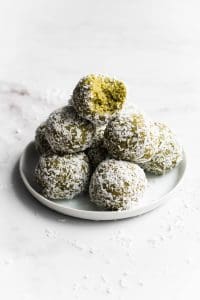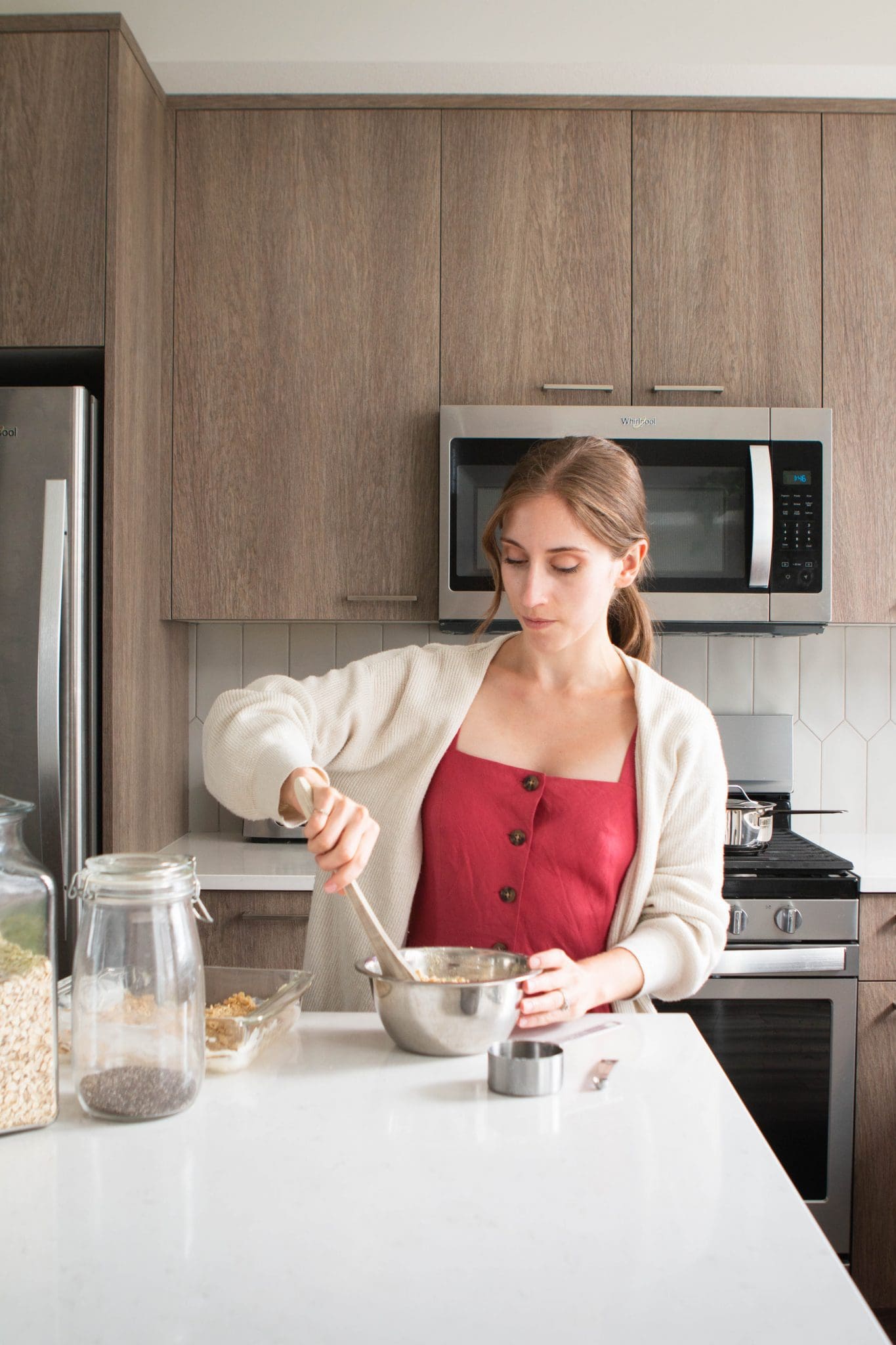Here are 10 gentle nutrition tips for vegans from a registered dietitian. The goal of these nutrition tips is to help support your health without focusing on restrictions and food rules.

Did you know that March is nutrition month? To start the month, I’m sharing 10 gentle nutrition tips for vegans.
What is Gentle Nutrition?
Gentle nutrition is the last principle of intuitive eating. It encourages you to honor your health with nutrition, while enjoying the foods that you love, without guilt.
It’s okay to choose foods for their nutritional quality. Just ask yourself:
- Am I enjoying these nutritious foods? Don’t force yourself to eat nutritious foods that you don’t enjoy.
- Do I have a medical condition that will be helped by paying attention to nutrition?
- Does thinking about nutrition feel neutral or does it trigger old diet thoughts?
- Am I able to eat pleasurable, but less nutritious foods, without feeling guilty?
The goal is not to eat “perfectly” (there’s no such thing) or to add rules to your diet.
If you’re new to intuitive eating, you can find more details in this post. I also highly recommend reading Intuitive Eating: A Revolutionary Program that Works. It’s a great place to start!
That being said, here are 10 gentle nutrition tips for vegans…

1. Substitute, Don’t Eliminate
Don’t just eliminate animal products from your diet and expect to improve your health and meet all of your nutrient needs. Vegan nutrition does require a little attention.
Instead of simply eliminating animal products, try substituting them with vegan alternatives. For example, substitute cow’s milk with fortified plant-based milk or meat with legumes. And yes, vegan meat alternatives can absolutely fit in a healthy eating pattern.
Not only will this help you meet your nutrient needs, but it will also help you feel more full and satisfied.
2. Take a B12 Supplement
While it’s possible to get most of the nutrients that you need on a vegan diet, it’s important to take a B12 supplement.
Yes, you can get vitamin B12 from fortified foods, such as nutritional yeast or plant-based milk, but this is not always reliable and you will likely not get the amount that you need. Take at least 2500mcg once per week for maintenance OR 1000mcg 2-3 times per week OR 25-200mcg daily. Talk to a dietitian as individual needs may differ and you might need more if you haven’t been supplementing in a while.
3. Consider a Vitamin D Supplement
Most vegans and non vegans need to take a vitamin D supplement. Yes, we can get some vitamin D from the sun, but there are many factors that can affect this, making it an unreliable source. Not to mention the risk we get from unprotected sun exposure.
It’s best to get blood work done to assess your vitamin D levels and to supplement accordingly. That being said, most people can benefit from a vitamin D supplement of at least 400IU. Keep in mind that vitamin D is a fat-soluble vitamin, so more is not better. 1000-2000IU daily is plenty for most people. Talk to your healthcare provider to make sure you’re taking the right amount for you.
4. Add variety to your diet
Try new vegan recipes, add different colors to your plate and/or experiment cooking with a new ingredient. Eating a variety of foods will ensure that you’re getting the nutrients that you need, plus it will keep your diet fun and exciting.
When possible, try balancing your plate with protein, carbohydrates, fat and fiber. This variety will help you feel satisfied at meals, while ensuring that you’re getting the nutrients that you need.
Plus, eating a greater variety of plant-based foods can have benefits for your gut microbiome!
5. Eat Omega-3 Rich Foods
Omega-3s are essential fatty acids that have a role in heart health and brain health. There are 3 forms of omega-3s: ALA, DHA and EPA.
You can get ALA from ground flax seeds, flax oil, chia seeds, walnuts and hemp hearts. Try getting 2-3 tablespoons of chia, flax or hemp seeds daily OR 1/4 cup of walnuts.
EPA and DHA are found in fish and seafood and those sea animals get it from algae. Vegans can get EPA and DHA from an algae supplement. As long as you’re getting enough ALA, you don’t need to supplement with EPA and DHA. That being said, a supplement can be more convenient and reliable if you’re not regularly eating ALA food sources.
6. Choose High Fiber Foods
Fiber is important for many reasons. It’s important for gut health and helps keep us regular, it helps reduce cholesterol, manage blood sugars and keeps us full for longer.
Try to include fiber-rich foods to your meals and snacks. Here are some ideas to get you started:
- Choose whole grains most of the time.
- Snack on a handful of nuts or seeds.
- Add nuts and seeds to salads or oatmeal.
- Fill half of your plate with vegetables or try to include at least one vegetable to most meals.
- Add beans, lentils or peas to your meals.
- Enjoy nut or seed butter on toasts, served in oatmeal or blended in smoothies.
If you’re not used to eating a fiber-rich diet, make sure to increase your fiber intake gradually and drink plenty of water to avoid any discomfort.
7. Eat Legumes Every Day
Yes, it is possible to get enough protein on a vegan diet. However, you do need to be intentional with adding protein sources to your diet to make sure you’re getting the amino acids that you need. Here’s my recommendation: Try to aim for 3-4 servings of legumes per day.
Legumes are a great source of plant-based protein and are rich in the amino acid lysine. Some examples of legumes and their serving size:
- 1/2 cup beans, chickpeas, peas, tempeh and tofu
- 1 cup soy milk
- 1/4 cup peanuts
- 2 tablespoons peanut butter
You will also get protein from grains, nuts, seeds, nutritional yeast and other plant foods, but aiming to get legumes at most meals will help you meet your protein needs more easily.
For more information about vegan protein sources and how to use them, check out this post.
8. Include Calcium-Rich Foods
While we don’t need cow’s milk to meet our calcium needs, we do need to be intentional about calcium. Try to include calcium-rich foods to your meals and snacks.
Calcium-rich plant-based foods: Fortified plant-based milk and plant-based yogurt, collard greens, spinach, kale, bok choy, almond butter, almonds, tahini, tempeh, calcium-set tofu, calcium-fortified orange juice.
Adults need 1000mg of calcium per day. It can be difficult to meet this through food, especially if you don’t consume fortified plant foods. If this is the case, you can consider taking a small calcium supplement. Talk to your healthcare provider before taking a calcium supplement to make sure you’re taking the right amount for you.
9. Use Iodized Salt or Consider a Supplement
Iodine is important for thyroid health. You can get iodine from dairy, eggs and sea animals. For vegans, the best source is iodized salt. You can also get iodine from seaweed, but this is an unreliable source. Some can contain very little iodine, while others contain too much.
If you don’t use iodized salt regularly (for most people, 1/2 teaspoon daily will get you what you need), consider taking an iodine supplement through a multivitamin or by itself.
10. Eat Enough
Last, but not least: Eat enough. Eating enough food every day will help you get the nutrients and energy you need to feel your best. If you find it difficult to eat enough as a vegan, try including nutrient and energy-dense foods, such as nuts, seeds, nut butters and avocados for example. And there’s no need to avoid using oil. Fats can help you get the energy that you need, plus help absorb fat-soluble vitamins. So don’t skip it!
Finally, if you’re hungry between meals, give your body what it needs and have a snack. Here are my tips to making satisfying vegan snacks. Everyone is different. Some prefer to eat 3 larger meals while others prefer to eat smaller meals with snacks in between. Do what works best for you.
Please note that when it comes to supplements, it’s best to talk to a dietitian as individual needs may differ. The suggestions above are general recommendations. For individualized advice, please consult a registered dietitian or health care provider.
Looking for dietitian support? Book a free 15-minute discovery call or an appointment with me here.
This information is intended for educational purposes only and is not meant to replace individualized nutrition or medical advice.












Leave a Reply